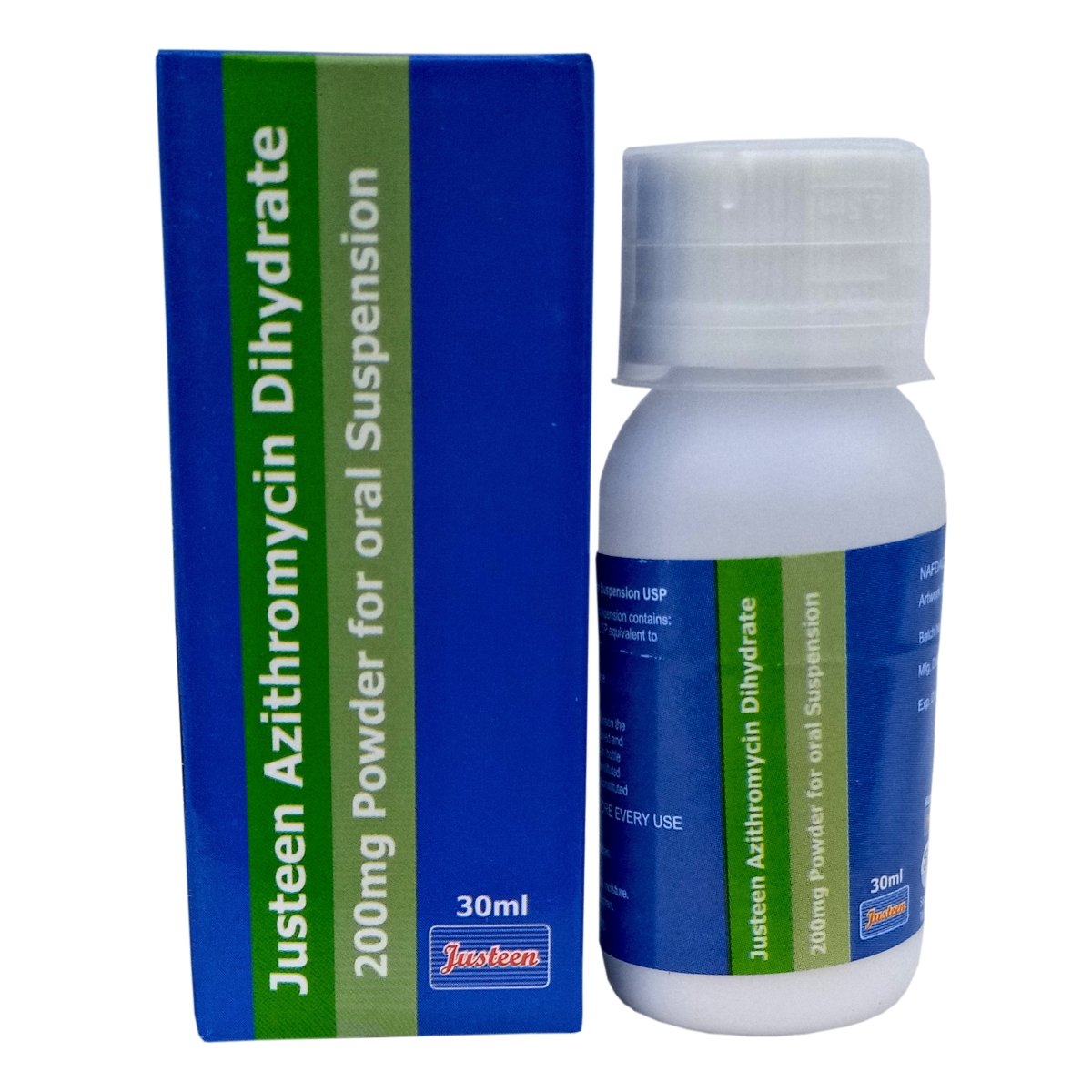
Justeen Azithromycin
JUSTEEN AZITHROMYCIN DIHYDRATE
Justeen Azithromycin Dihydrate 200mg powder for oral suspension
-
QUALITATIVE AND QUANTITATIVE COMPOSITION
Each 5 ml reconstituted suspension contains:
Azithromycin Dihydrate USP equivalent to Azithromycin : 200mg
Excipients : Q.S.
Colour : Erythrosine
Approved colour used in capsule shell.
-
PHARMACEUTICAL FORM
Dry Syrup For oral administration. -
CLINICAL PARTICULARS
Therapeutic indications
Azithromycin is indicated for the treatment of patients with mild to moderate infections caused by susceptible strains of the designated microorganisms in the specific condition listed below. As recommended dosages, durations of therapy and applicable patient population vary among these infection.Posology and method of administration
AZITHROMYClN SUSPENSION should be administered as a single dose daily and in common with many other antibiotics should be taken at least I hour before or 2 hours after food.
Adults and Elderly:
For sexually transmitted diseases caused by Chlamydia trachomatis the dose is I gr. given as a single dose. For all other indications. the total dose is 1.5 gr. which should be given as 500 mg daily for 3 days.Children:
AZITHROMYClN SUSPENSION should be used for children under 45 kg. There is no information on children under six months of age.Contraindications
Contraindicated in patients with known hypersensitivity to Azithromycin, erythromycin or any macrolide or ketolide antibiotic.Special warnings and precautions for use
Azithromycin should be used with caution in patients with illness or any allergy, especially allergies to drugs, liver disease, jaundice, history of colitis or stomach problems or kidney disease. This drug should be used only if clearly needed during pregnancy or lactation.Interaction with other medicinal products and other forms of interaction
Using azithromycin with any of the following medicines is not recommended. Your doctor may decide not to treat you with this medication or change some of the other medicines you take -Dihydroergotamine, Dronedarone, Ergoloid Mesylates, Ergonovine, Ergotamine, Methylergonovine, Methysergide, Pimozide.
Using azithromycin with any of the following medicines is usually not recommended, but may be required in some cases. If both medicines are prescribed together, your doctor may change the dose or how often you use one or both of the medicines -Acecainide, Amiodarone, Azimilide, Bretylium, Disopyrarnide, Dofetilide, Ibutilide, Propafenone, Sematilide, Sotalol, Tedisarnil.
Using azithromycin with any of the following medicines may cause an increased risk of certain side effects, but using both drugs may be the best treatment for you. If both medicines are prescribed together, your doctor may change the dose or how often you use one or both of the medicines - Atorvastatin, Digoxin, Fentanyl, Lovastatin, Nelfinavir, Rifabutin, Simvastatin, Theophylline, Warfarin.
Pregnancy and lactation
Pregnancy B:
There are no adequate studies in pregnant women studies have shown an adverse effect, but adequate studies in pregnant women have failed to demonstrate a risk to the fetus.Lactation:
Studies in women suggest that this medication poses minimal risk to the infant when used during breastfeeding.Undesirable effects
- diarrhoea
- difficulty breathing or swallowing
- hives
- hoarseness
- itching
- mild skin rash
- rapid, pounding, or irregular heartbeat
- severe skin rash
- stomach pain
- swelling of the face, throat, tongue, lips, eyes, hands, feet, ankles, or lower legs
- upset stomach
- vomiting
- yellowing of the skin or eyes
Overdose
People who take too much Azithromycin may have overdose symptoms that could include, but are not limited to:- Nausea
- Diarrhoea
- Vomiting
- Loss of strength
-
PHARMACOLOGICAL PROPERTIES
Pharmacodynamic properties
Azithromycin, an azolide, is a subclass of the macrolide antibiotics. It is derived from erythromycin, but its chemical structure differs slightly by having a methyl-substituted nitrogen atom in the lactone ring. Azithromycin has the ability to block protein synthesis. This drug is primarily bacteriostatic, but can be bactericidal depending on the concentration given. It is effective against aerobic Gram-positive microorganisms, and some Gram-negative organisms. However, Azithromycin does. not appear to have any inherent direct activity against Pseudomonas aeruginosa (a Gram-negative, rod-shaped, opportunistic pathogen).Pharmacokinetic properties
Azithromycin is absorbed both widely and rapidly throughout the body. When distributed in the body, concentrations are found to be greater in tissue compared to that of plasma-and serum levels. Due to Azithromycin's high oral bioavailability, long half-life, and ability to attain high tissue concentrations, it lends itself to a once daily dosing regimen. The drug undergoes some hepatic (liver) metabolism, with the majority of the drug being excreted in bile, and to a lesser extent in urine. -
PHARMACEUTICAL PARTICULARS
Special precaution for storage
Store below 30°C. Protect from heat, light & moisture.
KEEP OUT OF REACH OF CHILDREN


